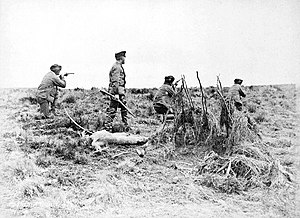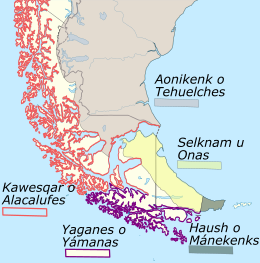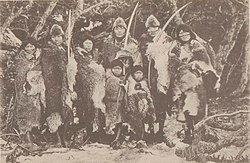Fuegians
Fuegians are the indigenous inhabitants of Tierra del Fuego, at the southern tip of South America.
The name has been credited to Captain James Weddell, who supposedly created the term in 1822.

The indigenous Fuegians belonged to several different tribes including the:
- Selk'nam, also known as Ona or Onawo
- Haush, also known as Manek'enk
- Yahgan, also known as Yagán, Yaghan, Yámana, Yamana, or Tequenica
- Kawésqar, also known as Alacalufe, Kaweskar, Alacaluf, or Halakwulup
All of these tribes except the Selk'nam lived exclusively in coastal areas and have their own languages. The Yahgan and the Kawésqar traveled by birchbark canoes around the islands of the archipelago, while the coast dwelling Haush did not. The Selk'nam lived in the interior of Isla Grande de Tierra del Fuego and were exclusively terrestrial hunter gatherers who hunted terrestrial game such as guanacos, foxes, tuco-tucos and upland nesting birds as well as littoral fish and shellfish. The Fuegian peoples spoke several distinct languages: both the Kawésqar language and the Yahgan language are considered language isolates, while the Selk'nam and Haush spoke Chon languages like the Tehuelche on the mainland.
Ethnonym
The name "Tierra del Fuego" may refer to the fact that both Selk'nam and Yahgan had their fires burn in front of their huts (or in the hut). In Magellan's time Fuegians were more numerous, and the light and smoke of their fires presented an impressive sight if seen from a ship or another island. Yahgan also used fire to send messages by smoke signals, for instance if a whale drifted ashore. The large amount of meat required notification of many people, so that it would not decay. They might also have used smoke signals on other occasions, but it is possible that Magellan saw the smokes or lights of natural phenomena.
History
Origin
Alongside the Pericúes of Baja California, the Fuegians and Patagonians show the strongest evidence of partial descent from the Paleoamerican lineage, a proposed early wave of migration to the Americas derived from an Australo-Melanesian population, as opposed to the main Amerind peopling of the Americas of Siberian (admixed Ancient North Eurasian and Paleo-East Asian) descent. Further credibility is lent to this idea by research suggesting the existence of an ethnically distinct population elsewhere in South America. According to archaeologist Ricardo E. Latcham the sea-faring nomads of Patagonia (Chono, Kawésqar, Yahgan) may be remnants from more widespread indigenous groups that were pushed south by "successive invasions" from more northern tribes.
Alternative origin speculations
However these previous claims were refuted by multiple genetic and anthropologic studies, such as one study published in Nature in 2018 which concluded that all Native Americans descended from a single founding population which initially split from East Asians c. 36,000 BC, with geneflow between Ancestral Native Americans and Siberians persisting until c. 25,000 BC, before becoming isolated in the Americas at c. 22,000 BC. Northern and Southern Native American subpopulations split from each other at c. 17,500 BC. There is also some evidence for a back-migration from the Americas into Siberia after c. 11,500 BC. Another study published in Nature in 2021, which analysed a large amount of ancient genomes, similarly concluded that all Native Americans descended from the movement of people from Northeast Asia into the Americas. These Ancestral Americans, once south of the continental ice sheets, spread and expanded rapidly, and branched into multiple groups, which later gave rise to the major subgroups of Native American populations. The study also dismissed the existence of an hypothetical distinct non-Native American population (suggested to have been related to Indigenous Australians and Papuans), sometimes called "Paleoamerican". The authors explained that these previous claims were based on a misinterpreted genetic echo, which was revealed to represent early East-Eurasian geneflow (close but distinct to the 40,000 BC old Tianyuan lineage) into Aboriginal Australians and Papuans.

European contact

When Chileans and Argentines of European descent studied, invaded and settled on the islands in the mid-19th century, they brought with them diseases such as measles and smallpox for which the Fuegians had no immunity. The Fuegian population was devastated by the diseases, and their numbers were reduced from several thousand in the 19th century to hundreds in the 20th century. In 1876 a serious smallpox epidemic decimated the Fuegians. Between 1881 and 1883 the Yahgan population dropped from perhaps 3,000 to only 1,000 due to measles and smallpox.
As early as 1878 Europeans in Punta Arenas seeking additional sheep pastures negotiated to acquire large tracts of land on Isla Grande de Tierra del Fuego from the Chilean government just prior to Argentina's and Chile's sovereignty there.
By 1876, Christian missionaries claimed to have converted the entire Yahgan people.
On May 11, 1830 four Yahgan were transported to England by the schooner Allen Gardiner, presented to the court, and resided there for a number of years before three were returned, including Fuegia Basket and Jemmy Button. The fourth died of smallpox.
The United States Exploring Expedition came in contact with the Fuegians in 1839. One member of the expedition called the Fuegians the "greatest mimics I ever saw."
Selk'nam genocide
The Selk'nam genocide was authorized and conducted by the estancieros that between 1884–1900 resulted in a severe indigenous population decline. Large companies paid sheep farmers or militia a bounty for each Selk'nam dead, which was confirmed on presentation of a pair of hands or ears, or later a complete skull. They were given more for the death of a woman than a man.
Modern history
Both Selk'nam and Yahgan were almost obliterated by diseases brought in by colonization, and probably made more vulnerable to disease by the crash of their main meat supplies (whales and seals) due to the actions of European and American fleets.
Culture
The principal differences in language, habitat, and adaptation techniques did not promote contacts, although eastern Yahgan groups had exchange contacts with the Selk'nam.
Material culture

"Archaeological investigations show the prevalence of maritime hunter-gatherer organization throughout the occupation of the region (6400 BP – 19th century)." Although the Fuegians were all hunter-gatherers, their material culture was not homogeneous: the big island and the archipelago made two different adaptations possible. Some of the cultures were coast-dwelling, while others were land-oriented. Neither was restricted to Tierra del Fuego:
- The coast provided fish, sea birds, otters, seals, shellfish in winter and sometimes also whales. Yahgan got their sustenance this way. Kawésqar (living in the Strait of Magellan and some islands), and Chono (living further to the north, on Chilean coasts and archipelagos) were similar. Most whales were stranded but some whaling occurred.
- Selk'nam lived on the inland plain of the big island of Tierra del Fuego, communally hunting herds of guanaco. The material culture had some similarities to that of the (also linguistically related) Tehuelche living outside Tierra del Fuego in the southern plains of Argentina.
All Fuegian tribes had a nomadic lifestyle, and lacked permanent shelters. The guanaco-hunting Selk'nam made their huts out of stakes, dry sticks, and leather. They broke camp and carried their things with them, and wandered following the hunting and gathering possibilities. The coastal Yahgan and Kawésqar also changed their camping places, traveling by birchbark canoes.
Gender
There is a belief in both the Selk'nam and Yahgan tribes that women used to rule over men in ancient times, Yahgan attribute the present situation to a successful revolt of men. There are many festivals associated with this belief in both tribes.
The patrilineal Selk'nam and the composite band society Yahgan reacted very differently to the Europeans and it has been suggested that this was due to these facets of their cultural structure.
Language
The languages spoken by the Fuegians are all extinct, with the exception of Kawésqar. The Selk'nam language was related to the Tehuelche language and belonged to the Chon family of languages. The Ona language had more than 30,000 words.
Mythology
There are some correspondences or putative borrowings between the Yahgan and Selk'nam mythologies. The hummingbird was an animal revered by the Yahgan, and in the Taiyin creation myth explaining the creation of the archipelago's water system, the culture hero "Taiyin" is portrayed in the guise of a hummingbird. A Yahgan myth, "The egoist fox", features a hummingbird as a helper and has some similarities to the Taiyin-myth of the Selk'nam. Similar remarks apply to the myth about the big albatross: it shares identical variants for both tribes. Some examples of myths having shared or similar versions in both tribes are:
- the myth about a sea lion and his [human] wife;
- the myth about the origin of death.
At least three Fuegian tribes had myths about culture heroes. Yahgan have dualistic myths about the two yoalox-brothers (IPA: [joalox]). They act as culture heroes, and sometimes stand in an antagonistic relation to each other, introducing opposite laws. Their figures can be compared to the Selk'nam Kwanyip-brothers. In general, the presence of dualistic myths in two compared cultures does not necessarily imply relatedness or diffusion.
Some myths also feature shaman-like figures with similarities in the Yahgan and Selk'nam tribes.
The abundant and nutritious Patagonian blennie (Eleginops maclovinus) was apparently not consumed and rock art suggests it may have had some religious significance.
Shamanism
Both Selk'nam and Yahgan had persons filling in shaman-like roles. The Selk'nam believed their xon (IPA: [xon]) to have supernatural capabilities, e.g. to control weather and to heal. The figure of xon appeared in myths, too. The Yahgan yekamush ([jekamuʃ]) corresponds to the Selk'nam xon.
There are myths in both Yahgan and Selk'nam tribes about a shaman using his power manifested as a whale. In both examples, the shaman was "dreaming" while achieving this. For example, the body of the Selk'nam xon lay undisturbed while it was believed that he travelled and achieved wonderful deeds (e.g. taking revenge on a whole group of peoples). The Yahgan yekamush made similar achievements while dreaming: he killed a whale and led the dead body to arbitrary places, and transformed himself into a whale as well. In another Selk'nam myth, the xon could use his power also for transporting whale meat. He could exercise this capability from great distances and see everything that happened during the transport.
See also
Notes
References
Further reading
- Oyola-Yemaiel, Arthur (1999). The Early Conservation Movement in Argentina and the National Park Service. Universal-Publishers. ISBN 9781581120981. Retrieved 24 January 2016.
- Vairo, Carlos Pedro (2002) [1995]. The Yamana Canoe: The Marine Tradition of the Aborigines of Tierra del Fuego. ISBN 978-1-879568-90-7.
External links

- Videos
- Balmer, Yves (2003–2009). "Fuegian Videos". Ethnological videos clips. Living or recently extinct traditional tribal groups and their origins. Andaman Association. Archived from the original on 2009-07-12. Retrieved 2009-05-30.
- Audio
- Lola Kiepja. Selk'nam (Ona) Chants of Tierra del Fuego, Argentina (Streamed tracks on Napster from the audio CD)).
- Excerpts from the same material on Amazon.com
- Bibliography, linking many online documents in various languages
- English
- Extinct Ancient Societies Tierra del Fuegians
- Indians page of homepage of Museo Maritiomo de Ushuaia
- German
- Dr Wilhelm Koppers: Unter Feuerland-Indianern. Strecker und Schröder, Stuttgart, 1924. (A whole book online. In German. Title means: “Among Fuegians”.)
- Die letzten Feuerland-Indianer / Ein Naturvolk stirbt aus. (Short article in German, with title “The last Fuegians / An indigenous people becomes extinct”)
- Feuerland — Geschichten vom Ende der Welt. (“Tierra del Fuego — stories from the end of the world”. Link collection with small articles. In German.)
- erdrand galleries, 9 photos
- Spanish
- Cosmología y chamanismo en Patagonia by Beatriz Carbonell. See abstract in English.
- About the Ona Indian Culture in Tierra del Fuego
- Rituals and beliefs of the Yahgan, mentioning “yekamush”
- (in Spanish) Cosmología y chamanismo en Patagonia by Beatriz Carbonell. See abstract in English.
This article uses material from the Wikipedia English article Fuegians, which is released under the Creative Commons Attribution-ShareAlike 3.0 license ("CC BY-SA 3.0"); additional terms may apply (view authors). Content is available under CC BY-SA 4.0 unless otherwise noted. Images, videos and audio are available under their respective licenses.
®Wikipedia is a registered trademark of the Wiki Foundation, Inc. Wiki English (DUHOCTRUNGQUOC.VN) is an independent company and has no affiliation with Wiki Foundation.